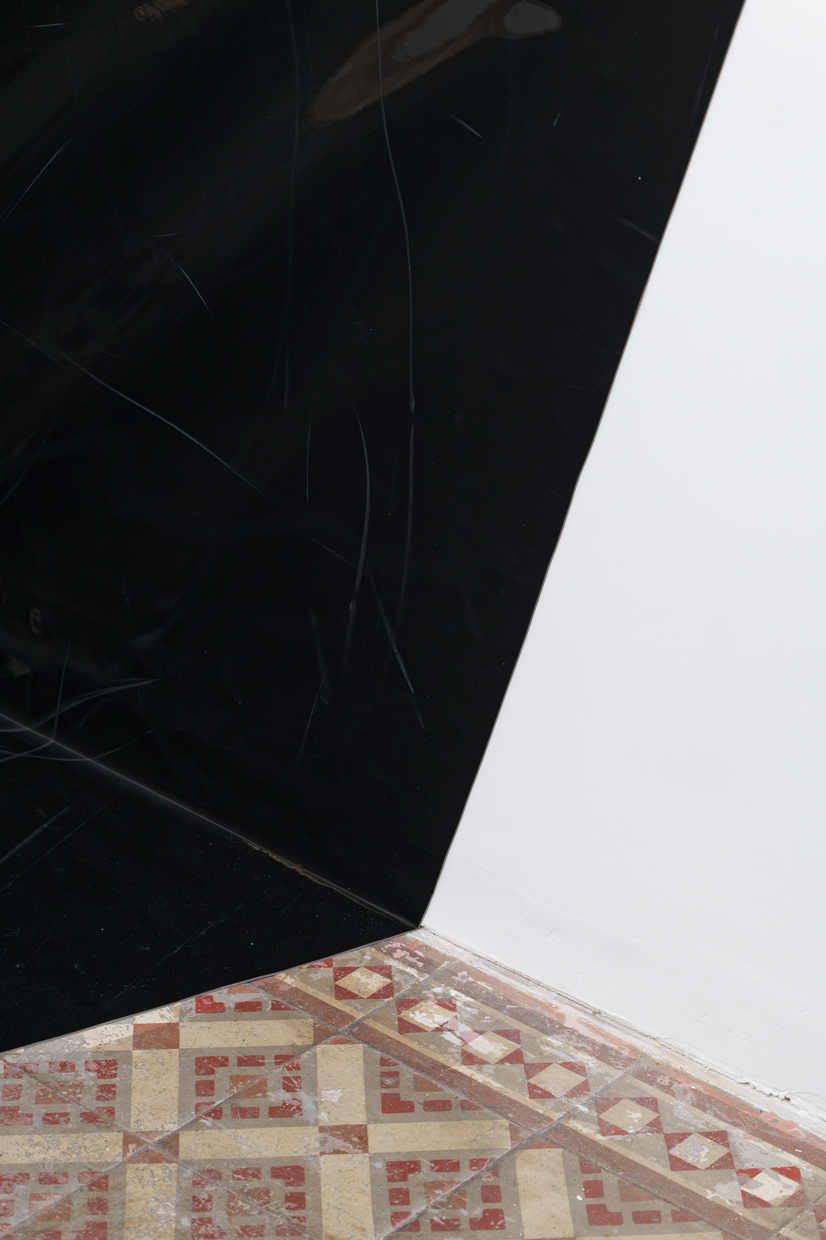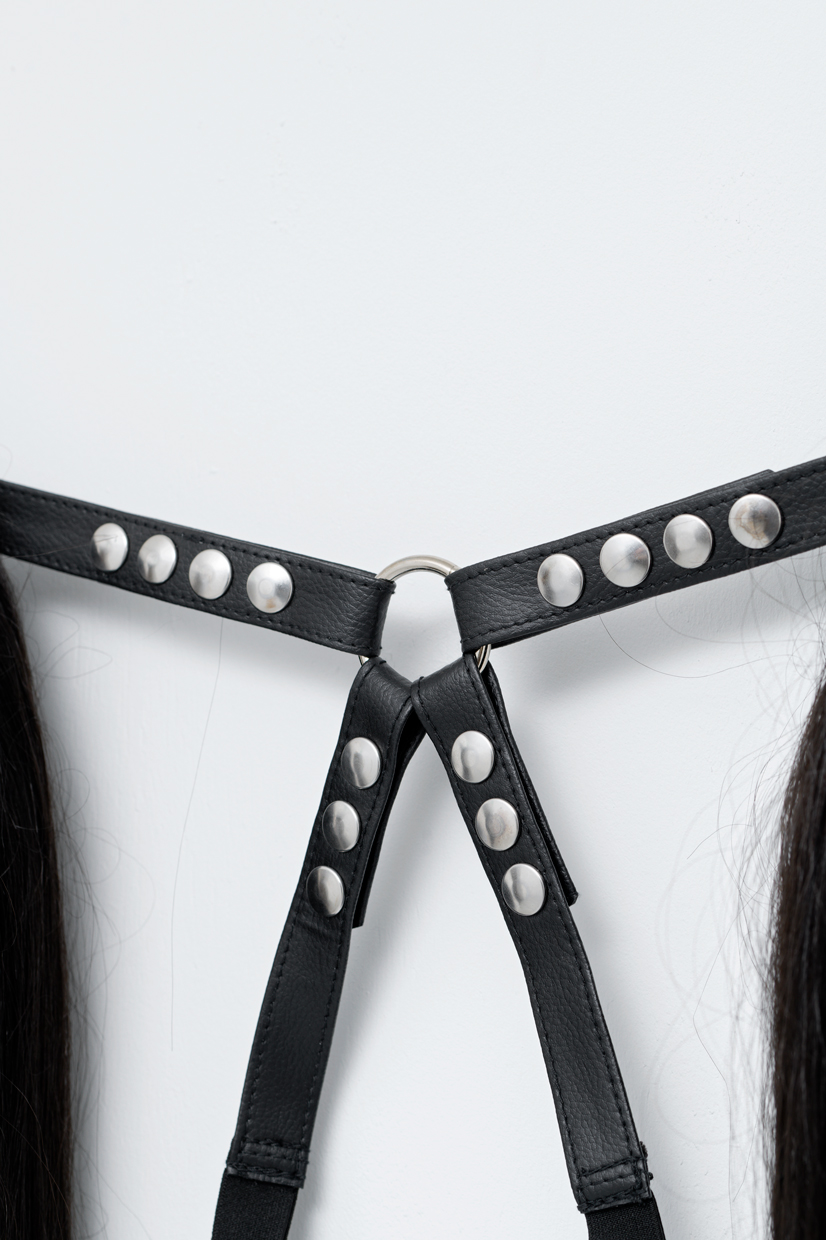
Future Traces
Pauline Boudry / Renate Lorenz
04.11.2021 - 08.01.2022, vernissage 04.11.2021

en français plus bas
"Yes to the consolidation of friendships.
Yes to staying with the trouble.
Yes to a fruitful continuity."
Volmir Cordeiro, Thèse-Mantra, Paris, 3 October, 2017
These consolidated friendships, this desired trouble and this fruitful continuity which Volmir Cordeiro talks about in his manifesto that has become a book* clearly reveal the so-called programming line or direction that we have so often been asked to define since the creation of Marcelle Alix in 2009.
It will always be through particular narratives that we will be able to say yes to the enhanced sensation of the good life, as well as a collective yes to a re-reading of art history focusing on alternatives to social norms and power relations. Our addressing devices (the artists, and ours) constantly bring us closer, for they put our bodies in action and such sensory flows constitute valuable knowledge in order to act. This is what Pauline Boudry / Renate Lorenz propose: to work with queer historical perspectives linked to a contemporary art practice while nurturing anachronism, a method that involves travelling back in time in order to engage with issues that still haunt the present. The body as a thought-provoking material has always been recurring, our programming is firmly directed towards eccentric abstraction that is built on margins. It helps us to believe that everything is possible, thanks to the play of embodiments and metamorphoses.
The work of Pauline Boudry / Renate Lorenz urges us to never lose sight of this bodily presence and this desire to be connected to other bodies in order to insure one's own persistence, as Volmir so aptly puts it. Dancing is a beautiful way of existing and protecting ourselves from destruction. Dancing allows us to move more freely and to be more responsive to the derision of thoughts. The body is undeniably an open system that produces forms of resistance and becoming. While dancing, the body is no longer devoid of visibility, rather it expands and becomes important. As in the work of Pauline Boudry / Renate Lorenz, the body can express tension through the extravagant joy of showing oneself, of not being alone and of responding to the waves of the other who is on stage as well as occupying the position of the viewer. We believe in artworks which have this necessary distance with the world and which know how to respond to it by choosing to highlight all the bodies that history has taken away from our perception. The films "Moving Backwards" (2019) and "(No) time" (2021) have this power of imagination triggered by bodily states whose moves are sometimes strangely reversible, in the margins of the spectacular world, beyond an oppressive past or present. The movements staged in both installations provide joy, spontaneity, excitement, freedom and detachment, allowing for the dancing of an "I" and an "u" beyond normative frameworks, built through clichés and social invisibility.
Around the installation "No time", new "freak" appearances are revealed in the gallery, referring to the physicality of the artwork as theorised by modernist historians while acknowledging an essential step aside. The "Wall Necklace pieces", made up of hundreds of gold imitation jewellery chains that are sometimes combined with safety chains in rusty metal or plastic, resonate with the artificial hair pieces, the "Wig pieces" which peopled their recent exhibitions and kept visitors company at the end of "Moving Backwards" at the Swiss Pavilion of the Venice Biennale (2019). The oversized necklaces assert the gender ambiguity of bling-aficionado rappers and of painting which long remained male-dominated according to art history. The "Dancefloor pieces" reveal, for their part, a form of contemporary Suprematism, wherein the dancefloor is promoted to the rank of the artwork, inseparable from a certain mysticism. Like the paintings that Kasimir Malevitch would hang on the ceiling, the latter, which are just as off-centred, stretch out from the ground to the ceiling, producing an overlapping of the infinite black cube of the nightclub and the abyss of the white cube exhibition space.
Marcelle Alix
* Volmir Cordeiro, EX-CORPO, Centre national de la danse, Pantin, 2019
translation: Callisto McNulty
Pauline Boudry / Renate Lorenz live in Berlin.
Their most recent video installation, "(No) Time", featuring choreographers/ performers Julie Cunningham, Werner Hirsch, Joy Alpuerto Ritter, Aaliyah Thanisha premiered at Frac Bretagne and is currently shown at Seoul Mediacity Biennale. It will be presented at CA2M Mostoles (Madrid) in 2022. "Moving Backwards", featuring choreographers/ performers Latifa Laâbissi, Werner Hirsch, Julie Cunningham, Marbles Jumbo Radio and Nach premiered at the Swiss Pavillon of the 58th Venice Biennale in 2019 and was recently presented at MUDAM Luxemburg and at the Pompidou Center ("Move" Festival). Solo exhibitions have included "Ongoing Experiments with Strangeness" at the Julia Stoschek Collection (2019), Berlin, "Telepathic Improvisation" at the Centre Culturel Suisse Paris (2018) and CAMH Houston (2017), "Portrait of an Eye" at Kunsthalle Zürich (2015) "Loving, Repeating" at Kunsthalle Wien (2015) "Patriarchal Poetry" at Badischer Kunstverein (2013), "Aftershow" at CAPC Bordeaux (2013), "Toxic Play in Two Acts" at South London Gallery (2012), and "Contagieux! Rapports contre la normalité" at the Centre d'Art Contemporain Geneva (2011).
They are represented by Ellen de Bruijne Projects in Amsterdam and Marcelle Alix in Paris.
Special thanks to: Etienne Bernard, Séverine Giordano, Morgane Estève (FRAC Bretagne), Caroline Ferreira d'Oliveira, Alice Pialoux (Centre Pompidou), Clovis Bataille.
--
"Oui au renforcement des amitiés.
Oui pour rester avec le trouble.
Oui à une continuité féconde."
Volmir Cordeiro, Thèse Mantra, Paris, 3 octobre 2017.
Ces amitiés renforcées, ce trouble désiré et cette continuité féconde dont parle Volmir Cordeiro dans sa thèse devenue livre* font clairement apparaître cette fameuse ligne ou orientation de programme que l'on nous a si souvent demandé de définir dès la création de Marcelle Alix en 2009.
Ce sera toujours à travers des récits particuliers que nous pourrons dire « oui à une sensation augmentée de bonne vie », ainsi qu'un oui collectif à une relecture de l'histoire de l'art privilégiant des alternatives face aux normes sociales et aux relations de pouvoir. Nos systèmes d'adresses (celles des artistes et les nôtres) nous rapprochent constamment, car elles mettent nos corps en action et ces flux sensoriels constituent de précieuses connaissances pour pouvoir agir. C'est ce que proposent Pauline Boudry/ Renate Lorenz : travailler sur des perspectives historiques queer liées à la pratique artistique contemporaine en cultivant l'anachronisme, une méthode qui consiste à remonter dans le passé pour aller à la rencontre des problématiques dont le présent reste hanté. Le corps comme matière à penser a toujours été une constante et notre programme, résolument tourné du côté d'une abstraction excentrique construite sur des marges. Il nous aide à croire que tout est possible, grâce au jeu des incarnations et des métamorphoses.
Le travail de Pauline Boudry/ Renate Lorenz nous invite à ne jamais perdre de vue cette présence corporelle et ce désir d'être lié à d'autres corps pour, comme le dit si bien Volmir, « s'assurer de sa propre persistance ». Danser est une belle manière d'exister et de se protéger de la destruction. Danser nous rend plus libres de nos mouvements et plus sensibles à la dérision des pensées. Le corps est indéniablement un système ouvert qui produit des résistances et des devenirs. En dansant, il n'est plus dénué de visibilité, mais se déploie et devient important. Il peut, comme dans l'œuvre de Pauline Boudry/ Renate Lorenz, exprimer des tensions à travers la joie extravagante de se montrer, de n'être pas seul·e et de répondre aux ondes de l'autre qui se trouve aussi bien sur scène qu'à la place de celle ou celui qui regarde. Nous croyons aux œuvres qui ont cette distance nécessaire avec le monde et savent lui répondre en choisissant de laisser apparaître tous les corps que l'histoire a enlevés à notre perception. Les films « Moving Backwards » (2019) et « (No) time » (2021) ont cette puissance d'imagination travaillée par des états du corps aux mouvements parfois étrangement réversibles, dans les marges du monde spectaculaire, au-delà d'un passé et d'un présent oppressants. Les mouvements mis en scène dans les deux installations apportent joie, spontanéité, excitation, liberté et détachement, permettant de danser un « soi » et un « nous » au-delà des cadres normatifs, construits par les clichés et les invisibilités sociales.
Autour de l'installation « No time », de nouvelles présences « freak » se déploient dans la galerie, se référant à la physicalité de l'œuvre d'art telle qu'elle a été théorisée par les historien·ne·s modernistes tout en admettant l'indispensable pas de côté. Les « Wall Necklace pieces » formées de centaines de chaînes fantaisie dorées parfois mêlées à des chaînes de sécurité en métal rouillé ou en plastique, font écho aux pièces en cheveux artificiels, les « Wig pieces » qui peuplaient leurs expositions récentes et tenaient compagnie aux visiteur·euse·s au sortir de « Moving Backwards » dans le Pavillon Suisse de la Biennale de Venise (2019). Les colliers oversize affirment l'ambiguïté de genre des rappeurs adeptes du bling et de la peinture longtemps restée masculine pour l'histoire de l'art. Les « Dancefloor pieces » relèvent quant à elles d'un suprématisme contemporain, pour lequel la piste de danse serait promue au rang d'œuvre d'art indissociable d'une certaine mystique. Comme les toiles que Kasimir Malevitch installait au plafond, ces dernières, tout aussi décentrées, s'allongent du sol au plafond jusqu'à superposer l'infini du cube noir du club à l'abîme du cube blanc de l'exposition.
Marcelle Alix
* Volmir Cordeiro, EX-CORPO, Centre national de la danse, Pantin, 2019
Pauline Boudry / Renate Lorenz vivent à Berlin.
Leur installation vidéo la plus récente, "(No) Time", avec les chorégraphes/interprètes Julie Cunningham, Werner Hirsch, Joy Alpuerto Ritter, Aaliyah Thanisha, a été créée au Frac Bretagne et est actuellement présentée à la Mediacity Biennale de Séoul. Elle sera exposée au CA2M à Mostoles (Madrid) en 2022. "Moving Backwards", avec les chorégraphes/interprètes Latifa Laâbissi, Werner Hirsch, Julie Cunningham, Marbles Jumbo Radio et Nach, a été présentée en avant-première au Pavillon suisse de la 58e Biennale de Venise en 2019 avant d'être exposée récemment au MUDAM Luxembourg et au Centre Pompidou à Paris dans le cadre du festival "Move". Parmi leurs expositions personnelles, on peut citer "Ongoing Experiments with Strangeness" à la Julia Stoschek Collection (2019), Berlin, "Telepathic Improvisation" au Centre Culturel Suisse Paris (2018) et au CAMH Houston (2017), "Portrait of an Eye" à la Kunsthalle de Zurich (2015), "Loving, Repeating" à la Kunsthalle de Vienne (2015), "Patriarchal Poetry" au Badischer Kunstverein (2013), "Aftershow" au CAPC de Bordeaux (2013), "Toxic Play in Two Acts" à la South London Gallery (2012), et "Contagieux ! Rapports contre la normalité" au Centre d'Art Contemporain Genève (2011).
Elles sont représentées par Ellen de Bruijne Projects à Amsterdam et Marcelle Alix à Paris.
Remerciements: Etienne Bernard, Séverine Giordano, Morgane Estève (FRAC Bretagne), Caroline Ferreira d'Oliveira, Alice Pialoux (Centre Pompidou), Clovis Bataille.












